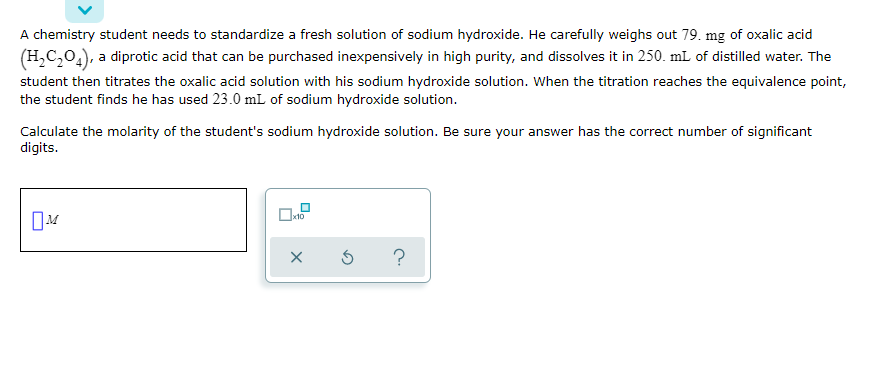A chemistry student needs to standardize a fresh solution of sodium hydroxide. He carefully weighs out 79. mg of oxalic acid (H,C,0,), a diprotic acid that can be purchased inexpensively in high purity, and dissolves it in 250. mL of distilled water. The student then titrates the oxalic acid solution with his sodium hydroxide solution. When the titration reaches the equivalence point, the student finds he has used 23.0 mL of sodium hydroxide solution. Calculate the molarity of the student's sodium hydroxide solution. Be sure your answer has the correct number of significant digits.
A chemistry student needs to standardize a fresh solution of sodium hydroxide. He carefully weighs out 79. mg of oxalic acid (H,C,0,), a diprotic acid that can be purchased inexpensively in high purity, and dissolves it in 250. mL of distilled water. The student then titrates the oxalic acid solution with his sodium hydroxide solution. When the titration reaches the equivalence point, the student finds he has used 23.0 mL of sodium hydroxide solution. Calculate the molarity of the student's sodium hydroxide solution. Be sure your answer has the correct number of significant digits.
Chemistry & Chemical Reactivity
10th Edition
ISBN:9781337399074
Author:John C. Kotz, Paul M. Treichel, John Townsend, David Treichel
Publisher:John C. Kotz, Paul M. Treichel, John Townsend, David Treichel
Chapter4: Stoichiometry: Quantitative Information About Chemical Reactions
Section4.8: Stoichiometry Of Reactions In Aqueous Solution-titrations
Problem 4.11CYU: Hydrochloric acid. HCl, with a concentration of 0.100 M can be purchased from chemical supply...
Related questions
Question

Transcribed Image Text:A chemistry student needs to standardize a fresh solution of sodium hydroxide. He carefully weighs out 79. mg of oxalic acid
(H,C,0,), a diprotic acid that can be purchased inexpensively in high purity, and dissolves it in 250. mL of distilled water. The
student then titrates the oxalic acid solution with his sodium hydroxide solution. When the titration reaches the equivalence point,
the student finds he has used 23.0 mL of sodium hydroxide solution.
Calculate the molarity of the student's sodium hydroxide solution. Be sure your answer has the correct number of significant
digits.
Expert Solution
This question has been solved!
Explore an expertly crafted, step-by-step solution for a thorough understanding of key concepts.
Step by step
Solved in 2 steps with 2 images

Knowledge Booster
Learn more about
Need a deep-dive on the concept behind this application? Look no further. Learn more about this topic, chemistry and related others by exploring similar questions and additional content below.Recommended textbooks for you

Chemistry & Chemical Reactivity
Chemistry
ISBN:
9781337399074
Author:
John C. Kotz, Paul M. Treichel, John Townsend, David Treichel
Publisher:
Cengage Learning

Chemistry
Chemistry
ISBN:
9781305957404
Author:
Steven S. Zumdahl, Susan A. Zumdahl, Donald J. DeCoste
Publisher:
Cengage Learning

Chemistry: An Atoms First Approach
Chemistry
ISBN:
9781305079243
Author:
Steven S. Zumdahl, Susan A. Zumdahl
Publisher:
Cengage Learning

Chemistry & Chemical Reactivity
Chemistry
ISBN:
9781337399074
Author:
John C. Kotz, Paul M. Treichel, John Townsend, David Treichel
Publisher:
Cengage Learning

Chemistry
Chemistry
ISBN:
9781305957404
Author:
Steven S. Zumdahl, Susan A. Zumdahl, Donald J. DeCoste
Publisher:
Cengage Learning

Chemistry: An Atoms First Approach
Chemistry
ISBN:
9781305079243
Author:
Steven S. Zumdahl, Susan A. Zumdahl
Publisher:
Cengage Learning


Chemistry: Principles and Reactions
Chemistry
ISBN:
9781305079373
Author:
William L. Masterton, Cecile N. Hurley
Publisher:
Cengage Learning

Chemistry: The Molecular Science
Chemistry
ISBN:
9781285199047
Author:
John W. Moore, Conrad L. Stanitski
Publisher:
Cengage Learning